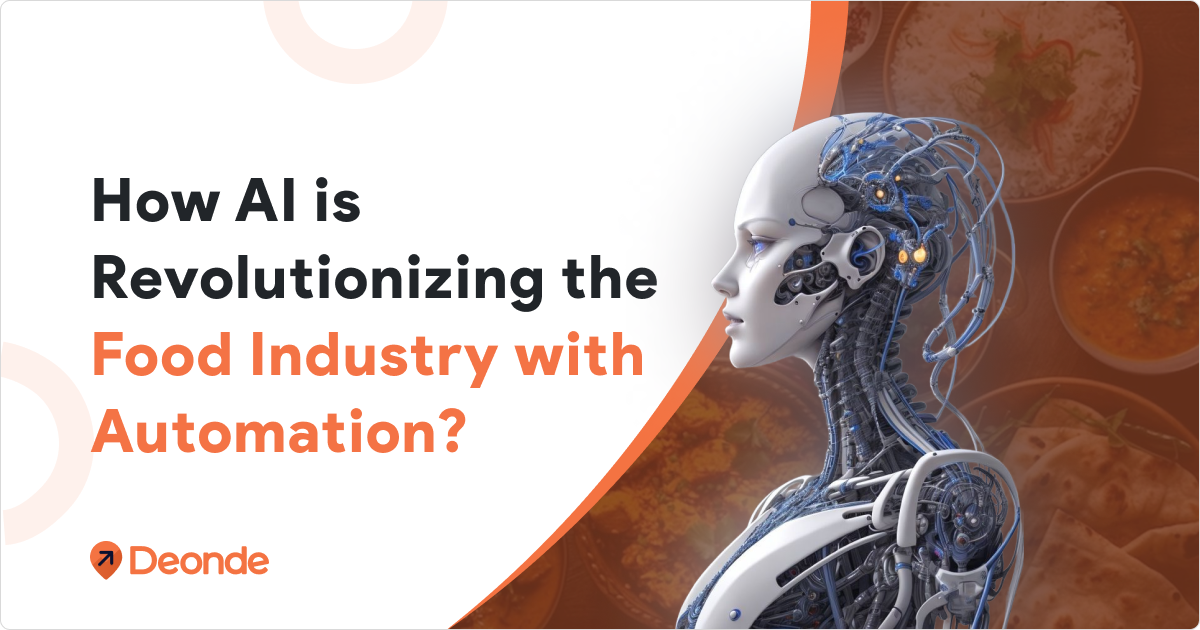Introduction
The words technology and food industry rarely go together. But what if they did?
Today, technology has become the cornerstone of innovation. If a business needs a competitive edge, despite its industry, it needs to leverage technology and AI in food industry automation.
AI truly is the key here. We regularly use open AI tools like Chat GPT, Perplexity, and Gemini AI.
What’s AI, And Why Is It So Buzzworthy?
AI assumes human-like intelligence and empowers computer systems to take on complex tasks that require cognitive reasoning. The one thing that distinguishes humans from the rest is this miraculous ability to think and conceive new ideas.
Now, imagine having a computer do that! The applications of AI are simply unimaginable.
It’s no news that a rather odd match of food and technology has combined forces today.
Technology is rapidly changing the face of the food industry with AI automation, natural language processing, algorithm training, and workflow optimization.
This is why today we’re discussing technology and AI’s role in the food industry. We’ll discuss AI’s implications, challenges, and impact on food and see how it has truly evolved the industry.
So, let’s get into it!
Role of AI in Food Industry
“All great changes are preceded by chaos” ~ Deepak Chopra.
It’s the year 2023. AI has taken all industries by storm and has become the heart of every strategic discussion, including the food industry.
From farming to food processing and last-mile logistics, AI has managed to address some of the most pressing challenges in the food industry.
The food industry can automate processes, make data-driven choices, and use sophisticated algorithms, AI, and robotics to serve a wider range of consumers.
For instance, in the United States alone, 30% of food generated is sent to the bins. That’s a net loss of $48.3 billion!
AI enables us to tackle this challenge of food waste head-on. It can drive efficiency and help businesses better manage their inventories. Also, AI can automate supply chains to reduce delivery schedule delays.
With appropriate optimization of resources, AI can address issues that have been long bothering the food industry.
AI can also help businesses in the food industry maintain and adhere to quality standards. For instance, AI can analyze data from temperature sensors and predict ideal temperatures for food storage and transport.
At this point, it feels important to mention that AI’s role is not limited to food manufacturing and processing units. AI has entered restaurant kitchens, grocery stores, food packaging, ordering, and home deliveries.
But how has AI become so accessible in the food industry? Let’s find out.
The Rise of AI in the Food Industry ft. Mobile App Developments
Mobile apps have made it easier for AI to penetrate the food industry.
For instance, let’s look at the popularity of online food ordering and delivery systems.
Food delivery apps like Uber Eats, Zomato, and Grubhub have lent users convenience.
As a result, everyone today is using these apps.
Such mobile apps serve as a threshold for AI. Companies developing these mobile apps are constantly leveraging the power of AI to generate source code, customize UI, and predict user preferences.
AI-based chatbots have become increasingly popular because they can immediately resolve queries and princess refunds. More time for a customer service representative on the phone. AI’s got your back!
Another area where AI has outdone itself in the food industry is optimizing last-mile logistics. AI can effectively plan on-demand delivery routes after considering traffic, peak hours, driver availability, and weather. It can also instantly adapt to any changes that come along the way, like accidents or road closures.
Today, people depend on mobile apps for everyday things, like ordering food or groceries, managing their health, and even consuming nutritional supplements. Through these apps, AI has comfortably dominated the food ordering, production, and delivery market.
Benefits of AI in the Food Industry
Now that AI is here let’s see how advantageous it has proved to be for business in the food industry:
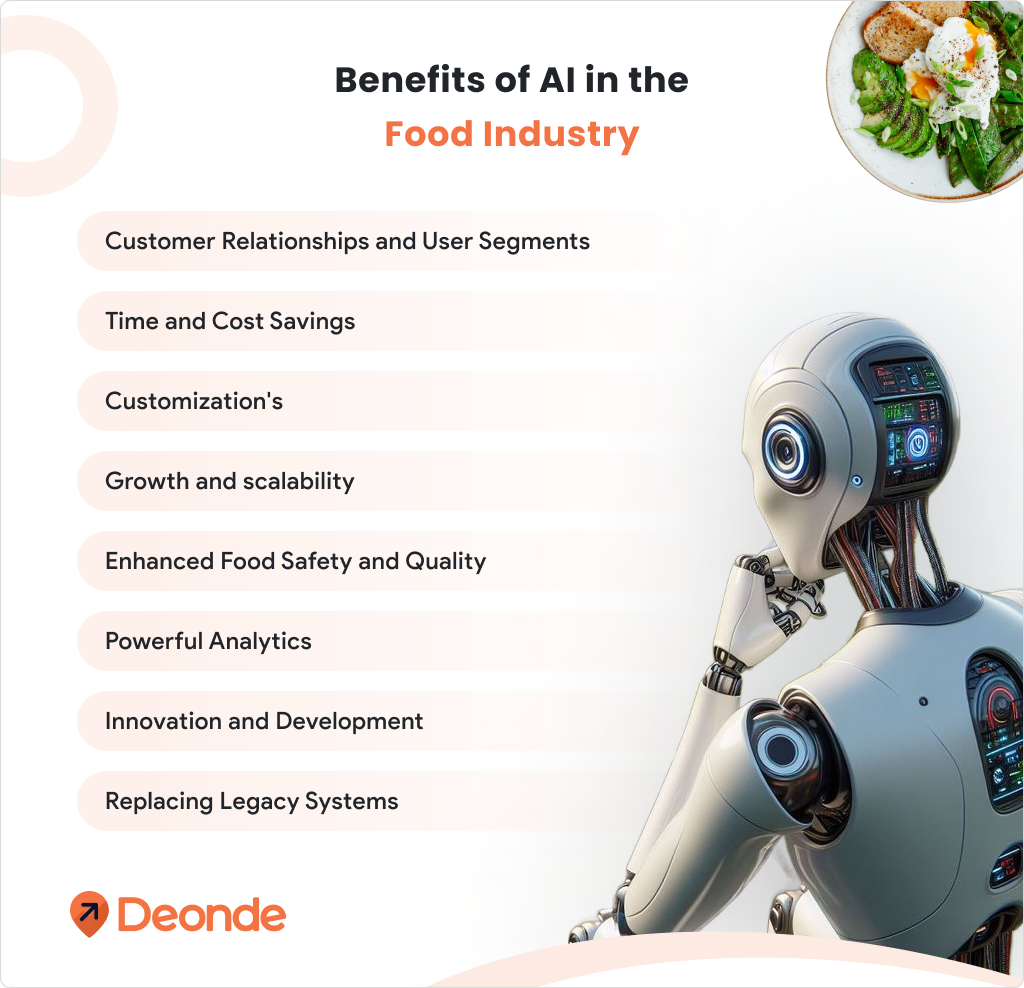
Increased Efficiency and Productivity
If it’s fast, it’s better.
Imagine yourself waiting at a kiosk at McDonald’s. You wouldn’t be willing to wait for more than a few minutes. Will you?
Quick service time is going to be an important market differentiator.
Food manufacturing and production houses, kitchens, and restaurants are all looking for one thing–higher efficiency.
And only AI can help with that.
AI can optimize workflows and supply chain management so food moves at lightning speeds without spoilage. As a result, less food is wasted, and customers can enjoy fresh food products.
Time and Cost Savings
As labour costs continue to rise, food businesses must find a way to do more with less. AI can help with that exactly. We are still years away from robots taking over the food industry, but AI can pick up the slack in the meantime.
We’ve already discussed AI chatbots’ use cases and how they’ve heightened customer satisfaction with 24/7 availability.
Similarly, AI can also be allotted repetitive tasks like data entry, payroll, and invoicing. AI can take on tedious manual tasks and finish them in the blink of an eye. Tasks that used to require a lot of human resources (like finances) can now be done by AI single-handedly with little to no errors.
Hence, AI is supercharging food operations and saving costs by reducing the need to hire more resources.
Customizations
AI can analyze customer data in seconds and generate reports to predict customer preferences and trends. Based on this data, businesses in the food industry can personalize product creation, menus, recipes, and even their operational workflows to meet consumer demands and increase overall satisfaction.
Growth and scalability
AI can help food businesses scale without having to invest in additional resources.
With the automation of everyday tasks, employees can focus on scaling and acquisitions. They can take on new clients or explore new geographical territories without worrying about customer management.
AI can handle a vast customer information and preferences database and assist in customer servicing through chatbots and virtual assistants.
AI can also assist in sales and marketing functions. Automation sales funnel with AI is as easy as a cakewalk. Also, marketing teams can use AI to generate content, create campaigns, and analyze KPIs.
Additionally, AI can generate schedules that boost employee productivity—so they can focus on sales.
Enhanced Food Safety and Quality
Adhering to compliance policies and maintaining high standards of quality is important for businesses in the food industry. AI can fast-track inspections with pre-built forms and timely follow-ups.
AI can also monitor and report data from sensory devices like temperature sensors, cameras, or volume measurement tools. With this data, businesses can detect contamination or spoilage and optimize these metrics to improve food sustenance and quality.
Above all, AI can help businesses maintain consistency in food quality, taste, and delivery.
Powerful Analytics
Use AI and dramatically reduce your data processing times.
AI can consolidate data and KPIs on a single interface, giving you all the visibility needed to make confident, data-driven decisions.
One area where AI can particularly help food industry businesses is pricing. The food industry’s market is extremely volatile, and the entry barrier to new competitors is extremely low. Hence, the pricing of food products and meals fluctuates.
AI can be very helpful here. It can analyze market trends and recommend pricing structures that work. It can also help sustain profit margins.
Innovation and Development
Gen AI is a force of creativity. If used correctly, it can cut down brain-storming sessions and fast-track research and development.
AI is teeming with product ideas that can aid new product development processes. It can also give feedback and predict the success of innovations.
Replacing Legacy Systems
Legacy systems have hindered workflow processes in the food industry. They are slow and cannot consolidate data. Integrating or even replacing these systems with AI-based apps will be game-changing.
By 2025, GenAI LLMs will interpret legacy databases and annotate them to logical processes. AI can effectively map out food inventories while managing employee/ delivery drivers’ data.
Moreover, AI can toggle between different datasets to produce a 360-degree view of data points and KPIs. Such data consolidation removes existing silos and empowers food businesses with streamlined processes.
AI Challenges in the Food Industry
AI is going to revoutionize the food industry. On paper, AI’s advanced capabilities sound empowering.
But the reality is sadly disappointing. Implementing AI tools with legacy systems or CRMs is easier said than done. Besides, affordability is a major challenge in this industry, with extremely thin profit margins.
So, let’s shed some light on factors that are affecting the impact of AI in the food industry:
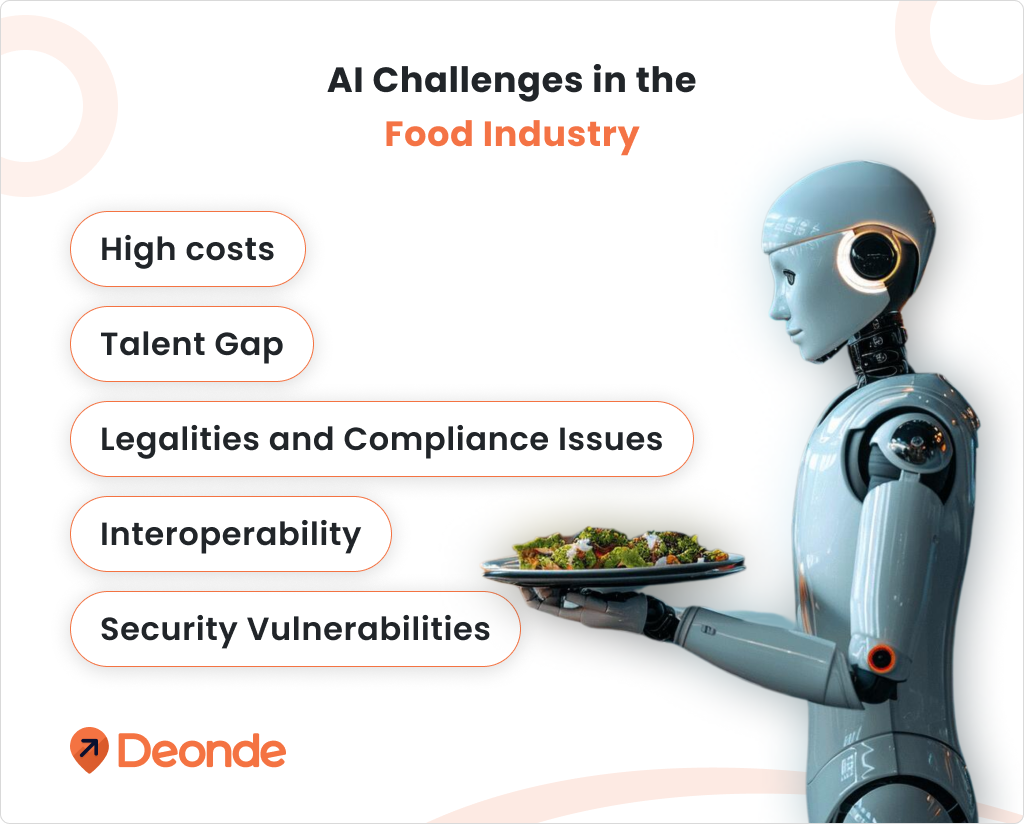
High Costs
Open AI tools are free or at least very affordable, but they are very limited in their capacity. Substantial investment is needed to capitalize on high-power AI/LLMs, which may pose a challenge to businesses that are barely making a profit in this industry.
Talent Gap
Implementing AI tools into food production workflows requires a talented workforce who understands the ins and outs of AI technologies. Unfortunately, since the concept of AI is new, many existing employees still struggle to grasp it. Or even if they do, they need more expertise. On the other hand, hiring new resources is again an added cost to the company.
Security Vulnerabilities
Is AI secure? The food industry constantly grapples with this question. AI’s forte is handling and processing data. However, trusting data with client-sensitive information can be a major challenge. Hence, robust security processes must be established to prevent data infringement or unauthorized access.
Legalities and Compliance Issues
The food industry has complex compliance requirements. Every business needs to uphold them to prevent legal undertakings. When leveraging AI, businesses need to be extra cautious with compliance. AI may need to be more familiar with industry regulations or, worse, may ignore them to achieve company goals. Hence, navigating food manufacturing policies with AI may be tricky.
Interoperability
Integrating AI tools with legacy systems is a technically challenging task. Not all existing systems are compatible with AI tools, which means that to wield the power of AI, they need to change their entire tech stack. This is a tough undertaking for SMBs.
How Can AI Be Used For Food Marketing?
Food Marketing with AI is another crucial aspect that food industry experts seldom talk about.
So, as we discuss the amalgamation of AI and food, we’ll also spend some time discussing its relevance in food marketing.
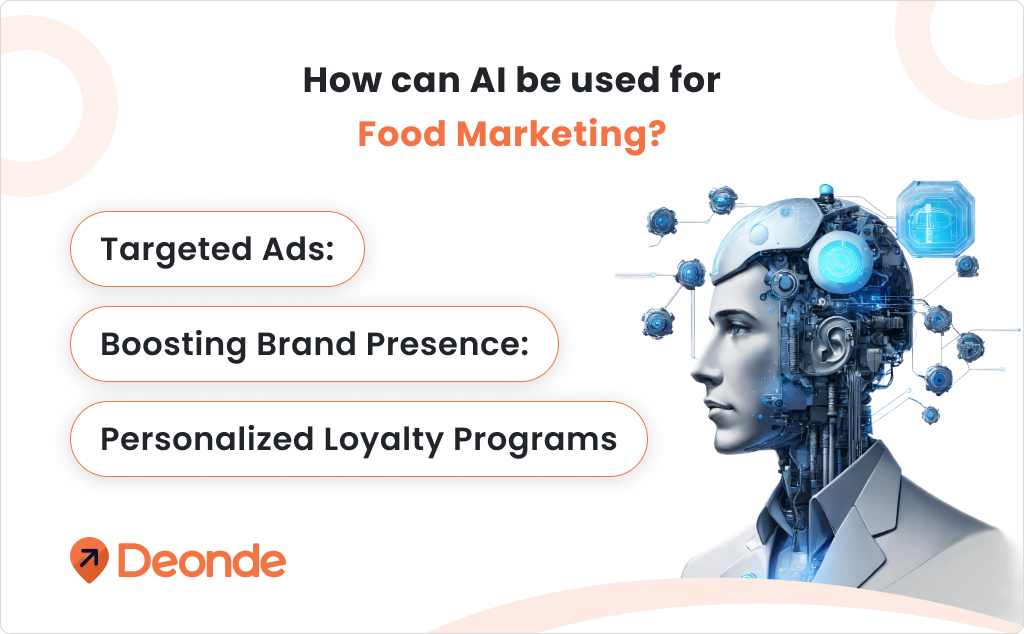
Targeted Ads:
AI algorithms can help identify ideal consumers and deliver hyper-personalized ads. For example, marketers can bombard online food delivery app users with customized ads that are influenced by their eating habits and preferences (like vegetarian, vegan, eggetarian, and more)
How to Create Marketing Strategies for Food Delivery Apps?
Boosting Brand Presence:
With AI analytics and data trends, food businesses can get an insight into the market and advertise products to boost brand presence. AI can help with ideating and outlining campaign goals. It can also monitor and optimize ad performance for greater visibility.
Personalized Loyalty Programs
In the food market, competition is fierce. You’ll find several businesses selling the same food products. Hence, in this space, customer loyalty is the only way to expand your profit margins. Customer loyalty is when a customer chooses you over your competitors again and again. But how can you do this? Well, AI is the answer! AI can help you personalize your clientele’s content, preferences, and menus. It can also address queries and heighten customer satisfaction with rewards and discounts.
Artificial Intelligence in Food Industry Examples
We say everyone is using AI. But can we back it up?
Here’s a list of food and beverage businesses using AI to automate their processes. You’ll find that some of the most successful giants, like Coca-Cola and Starbucks, using AI in extremely unique ways:
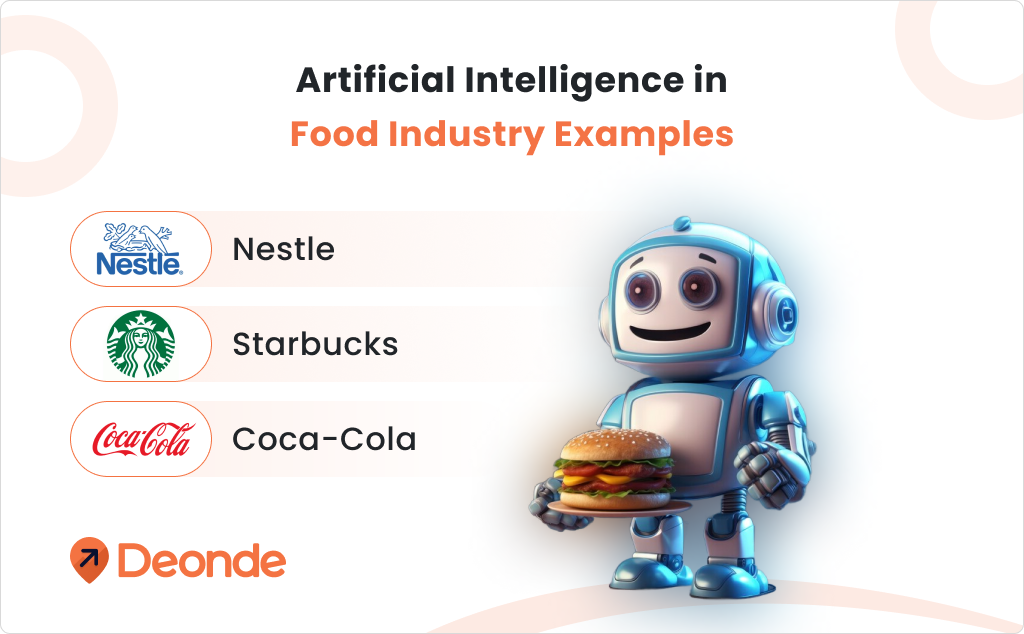
1. Nestle
Nestle is known for its ground-breaking product portfolio. Be it coffee, breakfast cereal, or refreshing beverages—everyone loves Nestle! And no surprise, Nestle uses AI to ideate and develop new products. Using AI, Nestle can conduct comprehensive industry research to identify food trends and fads. This is an excellent starting point, as using this, Nestle’s R&D team can create products that will resonate with the market and get traction.
2. Starbucks
Starbucks is known for its customer service. Starbucks relies on customer loyalty for profitability and scalability as a coffee, tea, and beverage vendor. Starbucks has such a loyal customer base because it offers seamless consumer experiences across multiple channels. Starbucks actively uses AI to personalize customer experiences by tailoring its recommendations. AI analyzes order history and geography to understand customer preferences!
3. Coca-Cola
Big brands like Coca-Cola depend on AI to supercharge their supply chains. Because Coke is widely distributed across many geographies, hence, the company needs to monitor and manage deliveries. By introducing AI automation, Coca-Cola has aced supplier relationship management, inventory management, and last-mile deliveries. It also uses route optimization and driver scheduling to enable timely deliveries.
Conclusion
It’s impossible to ignore AI’s effect on the food industry. AI can improve resource allocation and inventory stocking. It can automate workflows and streamline processes for higher productivity. It can also cut costs by reducing dependence on human resources.
However, one of the most appealing elements of AI in the food industry is its ability to respond quickly to market demands and fluctuations.
The biggest advantage of AI right now is data consolidation and the ability to gain KPI transparency. Food businesses can also use AI to make data-driven decisions to more useful serve their customers and increase their outreach. more useful
Like it or hate it, AI is here to stay. Need help integrating AI with your online food ordering and delivery platform? Let us know, and we can help!
FAQs
1. Which AI Components are Crucial in the Food Industry?
Machine learning and NPL (or natural language processing) are important AI components that can drive innovation in the food industry. Machine learning teaches and trains systems so operations can happen based on data and experiences. NPL, on the other hand, helps computer systems understand human speech and text so they can operate in alignment with human commands.
2. How Can the Food Industry Benefit from Robotics?
Robotics is the future. Soon, the manual workforce will get all their needed help through robots and drones. In the food industry, robotics can help fast-track packaging, delivery, processing, and farming activities like harvesting and weeding.
3. How Can AI Improve Customer Experience?
AI chatbots can assist food and beverage companies improve their customer experience services. Not only can AI offer 24/7 customer support, but it can also personalize the online food ordering experience with customized menus and discounts. In some cases, AI can predict customer reactions, preempt solutions, and even escalate issues for faster resolutions.
4. How Can AI Boost Supply Chain Management?
AI can drive efficiency by automating supply and delivery chains. Coordinating with suppliers and chasing delivery drivers will no longer be human tasks. By integrating supplier data and vehicle live-tracking and live-tacking, AI can effectively coordinate the supply of food items and lead to successful deliveries.
5. Does Deonde Leverage AI for its White-label Food Ordering and Delivery Systems?
Deonde believes in implementing modern technology like AI tools to boost online food ordering and delivery experiences. For customers, Deonde offers AI-driven chatbots so they can quickly resolve their queries. Deonde leverages AI widgets for the admin panel to analyze KPIs and other business data points.
